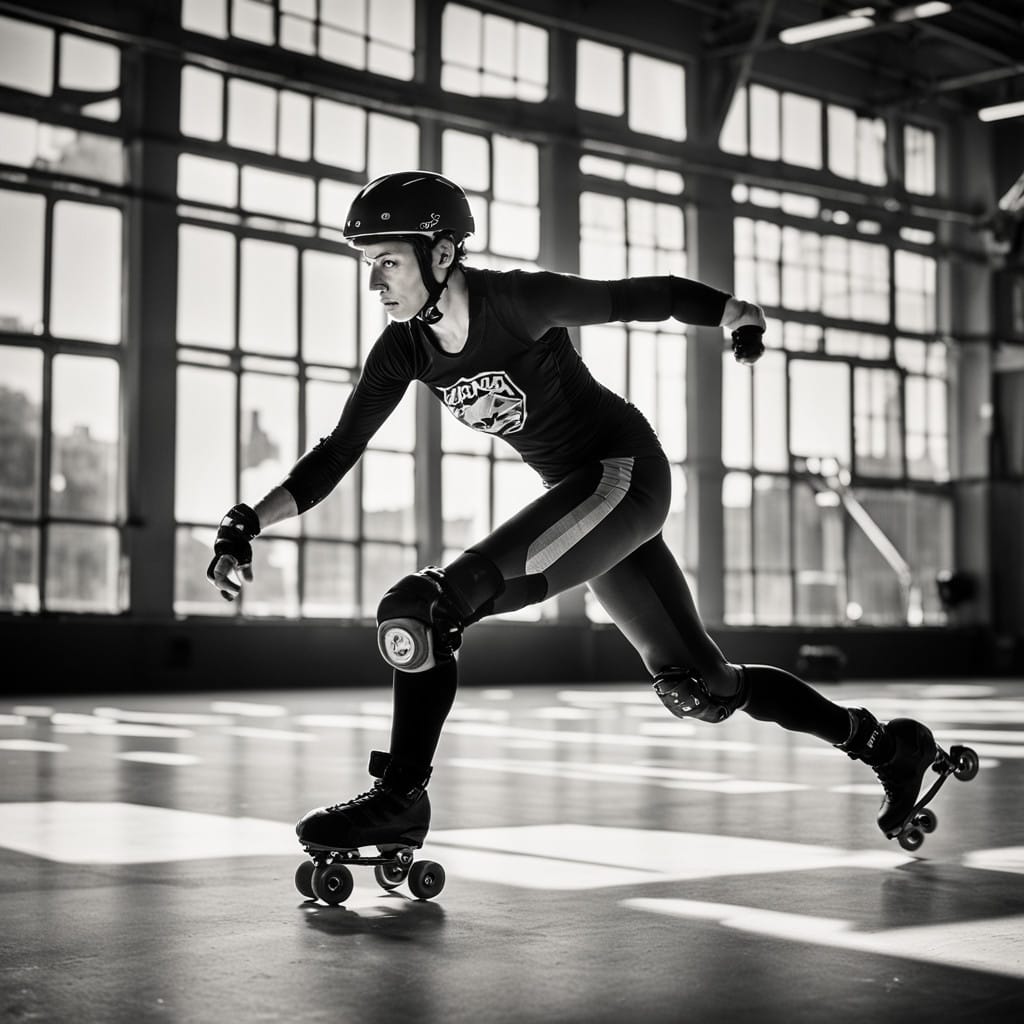Roller Derby, an intense and fast-paced contact sport, has captivated audiences for decades. Its unique combination of athleticism, strategy, and grit makes it a fascinating spectacle. In this blog post, we will explore the sport’s rich history, its rise to global popularity, and how it is played both at amateur and professional levels. We will also delve into the political and social significance of Roller Derby and examine its rules. By the end of this post, you will have a comprehensive understanding of this dynamic sport and why it has garnered a passionate following worldwide.

The Origin and History of Roller Derby
The history of Roller Derby is as vibrant and dynamic as the sport itself. The sport traces its roots back to the Great Depression era in the United States. In the 1930s, a man named Leo Seltzer, who was a film publicist and sports promoter, conceived the idea of Roller Derby. The initial concept was a roller skating endurance race called the “Transcontinental Roller Derby”. This mimicked the long-distance marathon dances that were popular during that time.
These endurance races involved teams of two (one man and one woman) skating around a track for extended periods, sometimes up to 3,000 miles. The goal was to outlast the other teams. However, as the races progressed, the contact between skaters became more frequent and intense. It wasn’t long before the physicality and excitement of the contact overshadowed the endurance aspect. This led to the sport’s evolution into the contact-heavy, competitive game we know today as Roller Derby.
By the 1940s, it had evolved into a full-fledged sport with teams, rules, and a growing fan base. The sport gained national attention through radio broadcasts. By the 1950s, it had made its way onto television screens across America. The televised matches featured theatrical elements, with skaters adopting personas and engaging in scripted rivalries. This helped immensely to boost its popularity. However, this period of Roller Derby was as much entertainment as it was sport. This led many to question its legitimacy as a competitive endeavor.
Despite the sport’s popularity in the mid-20th century, it experienced a decline in the 1970s and 1980s. The rise of other forms of entertainment and the increasing commercialization of sports led to it fading from the public eye. However, this was not the end for the sport.
The Resurgence and Global Popularity of Roller Derby
The late 1990s and early 2000s saw a revival of Roller Derby, largely driven by grassroots movements. This new wave of Roller Derby was different from its earlier incarnations. The sport was reimagined as a serious, athletic competition, with a focus on empowerment, particularly for women. Modern Roller Derby emerged as a predominantly female-led sport, though it is open to all genders.
The revival began in Austin, Texas, where the Texas Rollergirls league was founded in 2003. This league emphasized athleticism, competition, and community, marking a departure from the more theatrical versions of it in the past. The success of the Texas Rollergirls inspired the formation of new leagues across the United States and eventually worldwide.
Today, it is played in more than 60 countries, with thousands of leagues and teams. The sport’s popularity has spread to Europe, Australia, South America, and Asia. Countries like the United Kingdom, Canada, Australia, and Germany boast strong Roller Derby communities. The Women’s Flat Track Derby Association (WFTDA) was established as the governing body for the sport, providing standardized rules and organizing international competitions.
The global popularity of Roller Derby can be attributed to several factors. Firstly, the sport’s inclusivity has been a major draw. It welcomes participants of all shapes, sizes, and backgrounds, fostering a sense of community and belonging. Additionally, the DIY ethos of Roller Derby leagues, which are often player-run and self-funded, has resonated with those who value independence and creativity.
The rise of social media and online platforms has also played a significant role in spreading the sport’s popularity. Its leagues and teams use these platforms to share their stories, promote events, and connect with fans, helping to build a global Roller Derby community.
Amateur Roller Derby: Youth and School Leagues
Amateur Roller Derby has grown significantly alongside the professional scene. Youth and school leagues play a crucial role in the sport’s development. Many young skaters are drawn to it for its unique combination of physicality, strategy, and teamwork, as well as its emphasis on empowerment and inclusivity.
Youth Roller Derby leagues often cater to different age groups, ranging from juniors (typically ages 7-17) to young adults. These leagues provide a structured environment for young skaters to learn the fundamentals of the sport, develop their skills, and compete in a safe and supportive setting. The focus in youth Roller Derby is not just on competition but also on personal growth, teamwork, and sportsmanship.
Schools and community organizations have also embraced it as a way to engage students in physical activity. It also promotes values such as cooperation, resilience, and self-confidence. In some regions, school-based Roller Derby teams have become popular, with inter-school competitions providing a platform for young skaters to showcase their talents.
The growth of amateur Roller Derby has been supported by organizations like the Junior Roller Derby Association (JRDA). They provide resources, training, and support for youth leagues worldwide. The JRDA also organizes national and international tournaments, giving young skaters the opportunity to compete at a high level and gain exposure to different playing styles and strategies.
Professional Leagues and International Competitions
The professional Roller Derby scene is thriving, with numerous leagues and competitions taking place around the world. These leagues vary in size and structure. They all share a common goal: to promote and advance the sport of Roller Derby.
One of the most prominent professional leagues is the Women’s Flat Track Derby Association (WFTDA), which governs the sport at an international level. The WFTDA oversees more than 450 leagues in countries such as the United States, Canada, the United Kingdom, Australia, and Germany. The association organizes the annual WFTDA Championships. This event brings together the top teams from around the world to compete for the coveted Hydra Trophy.
In addition to the WFTDA, there are other organizations that govern and promote it at a professional level. The Men’s Roller Derby Association (MRDA) was established to support the growth of men’s Roller Derby, while the World Flat Track Derby Association (WFTDA) governs international competitions and provides support for leagues outside of North America.
Professional Roller Derby has also gained attention through major events such as the Roller Derby World Cup, which features national teams from around the world. The World Cup, first held in 2011, has become one of the most prestigious events in the Roller Derby calendar, showcasing the best talent and fostering international camaraderie.
The professional Roller Derby scene is characterized by its high level of competition, with teams and skaters dedicating countless hours to training and preparation. The sport’s physical demands require skaters to be in peak condition, with a focus on speed, agility, strength, and endurance. However, it is not just about physical prowess; it also requires strategic thinking, quick decision-making, and effective communication among teammates.
Political and Social Significance of Roller Derby
It is more than just a sport; it is a social and political movement. The sport has long been associated with feminist ideals, empowerment, and inclusivity, making it a powerful platform for social change. Many participants see it as a way to challenge traditional gender norms, promote body positivity, and create a space where everyone is valued and respected.
The resurgence of Roller Derby in the early 2000s coincided with the rise of third-wave feminism, which emphasized diversity, individuality, and self-expression. It became a natural fit for these ideals, with its emphasis on strength, autonomy, and community. The sport has provided a space for women and marginalized groups to assert their identities and take control of their narratives.
Roller Derby leagues often operate on a DIY model, with players taking on roles such as coaches, referees, and organizers. This player-run structure fosters a sense of ownership and empowerment, as participants are directly involved in the decision-making process. The DIY ethos also encourages creativity and innovation, with leagues often developing their unique identities and traditions.
In addition to its feminist roots, it has also been a platform for activism on other social issues. Many leagues and teams use their platforms to raise awareness about issues such as LGBTQ+ rights, racial justice, and mental health. Roller Derby events often feature fundraisers and community outreach initiatives. This helps demonstrate the sport’s commitment to making a positive impact beyond the track.
The inclusive nature of it has also made it a welcoming space for LGBTQ+ individuals. Many leagues actively promote LGBTQ+ inclusion, and the sport’s culture of acceptance and respect has made it a safe haven for those who may not feel comfortable in more traditional sports settings. The visibility of LGBTQ+ skaters and teams in Roller Derby has helped to challenge stereotypes and promote acceptance.
The Rules of Roller Derby
Understanding the rules of Roller Derby is essential for appreciating the complexity and excitement of the sport. It is typically played on a flat, oval track by two teams of 15 players each. However, only five players from each team are on the track at any given time. These players consist of a jammer, a pivot, and three blockers.
The jammer is the player responsible for scoring points. To score, the jammer must lap members of the opposing team while staying within the bounds of the track. Each opposing player passed earns the jammer one point. The pivot, identifiable by a stripe on their helmet, is a blocker who may also become a jammer if they take the star helmet cover from the jammer during play.
The blockers’ primary job is to prevent the opposing jammer from passing them while assisting their own jammer in scoring. Blockers play a crucial role in both offense and defense. Their task is to create opportunities for their jammer by forming effective formations and blocking the opposing jammer. They must adhere to specific rules and strategies to avoid penalties.
Penalties are a significant aspect of Roller Derby. Infractions are categorized into major and minor penalties. Major penalties result in a player being sent to the penalty box for 30 seconds. Examples include illegal hits or actions that endanger other players. Minor penalties may also lead to a stint in the penalty box, but they are less severe. The penalty box serves as a temporary area where players must wait before returning to the track. This can often impact their team’s performance and strategy.
Periods and Scoring: A Roller Derby bout is typically divided into two halves, each lasting 30 minutes. The game is played in a series of short segments called “jams,” which last up to two minutes. During each jam, teams attempt to score points while simultaneously defending against the opposing team’s jammer. The team with the most points at the end of the bout wins.
Gameplay Dynamics: It is a fast-paced game that combines speed, strategy, and physicality. Teams use various strategies, such as “pack formations,” to control the flow of the game and assist their jammer. Effective teamwork and communication are essential for executing these strategies successfully.
The rules of Roller Derby are designed to ensure player safety while maintaining the sport’s high energy and competitiveness. The continuous evolution of these rules reflects the sport’s growth and the ongoing efforts to balance safety with the exciting nature of the game.
The Future of Roller Derby
The future of Roller Derby looks promising as the sport continues to expand and evolve. With a growing global community, increased visibility through media and social platforms, and a commitment to inclusivity and empowerment, it is poised to reach new heights.
Technological Advancements: Technology is playing an increasingly important role in the sport. Innovations such as video replay and advanced analytics are being used to enhance gameplay and improve decision-making. These advancements not only contribute to the sport’s professionalism but also provide fans with a more engaging viewing experience.
Youth Development: The growth of youth Roller Derby is expected to continue, with more schools and community organizations adopting the sport. This focus on youth development will help ensure a steady influx of new talent and maintain the sport’s vitality for years to come.
Global Expansion: As it continues to spread across the globe, new leagues and teams will likely emerge in regions where the sport is currently less prominent. This expansion will contribute to the sport’s diversity and help build a more interconnected Roller Derby community.
Social Impact: The sport’s commitment to social issues is expected to remain a central aspect of its identity. Roller Derby leagues and teams will likely continue using their platforms to advocate for important causes and promote positive change within their communities.
In summary, it is a dynamic and evolving sport with a rich history and a bright future. Its global popularity, inclusivity, and commitment to social issues make it a unique and compelling part of the sports landscape. As the sport continues to grow and adapt, it will undoubtedly continue to captivate audiences and inspire new generations of skaters and fans.
Final Thoughts
Roller Derby’s blend of athleticism, strategy, and empowerment makes it a standout sport in the global arena. Its history reflects a journey from endurance racing to a competitive, inclusive game that challenges traditional sports norms. With its thriving amateur scene, vibrant professional leagues, and significant social impact, Roller Derby is more than just a sport; it is a movement that continues to inspire and unite people worldwide.
Whether you’re a seasoned skater or new to the sport, Roller Derby offers a unique and exhilarating experience. Its growth and evolution over the years highlight its resilience and appeal. As we look to the future, one thing is certain: Roller Derby will continue to make waves, both on and off the track.





